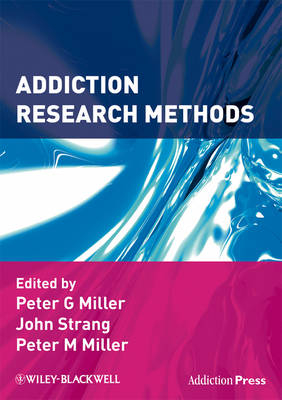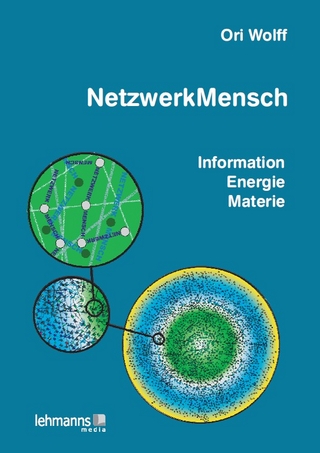
Addiction Research Methods
Wiley-Blackwell (Verlag)
978-1-4051-7663-7 (ISBN)
Addiction Research Methods’ is a comprehensive handbook for health professionals, policy-makers and researchers working and training in the field of addiction. The book provides a clear, comprehensive and practical guide to research design, methods and analysis within the context of the field of alcohol and other drugs. The reader is introduced to fundamental principles and key issues; and is orientated to available sources of information and key literature.
Written by a team of internationally acclaimed contributors, the book is divided into six major sections: Introduction; Research Design; Basic Toolbox; Biological Models; Specialist Methods; and Analytical Methods. Each chapter offers an introduction to the background and development of the discipline in question, its key features and applications, how it compares to other methods/analyses and its advantages and limitations.
FEATURES
List of useful websites and assistive technology.
Case study examples
List of useful hermeneutics
Recommended reading list
Contains exercises to help the reader to develop their skills.
Peter G Miller is NHMRC Howard Florey Fellow in the School of Psychology at Deakin University, Australia. He is Commissioning Editor for the journal, Addiction. John Strang is Professor of the Addictions and Director of the National Addiction Centre, University of London. He is also Clinical Director of the addictions treatment services at the South London & Maudsley NHS Foundation Trust. Peter M Miller is Professor of the Department of Psychiatry and Behavioral Sciences at the Medical University of South Carolina. He is Editor-in-Chief of the journal, Addictive Behaviors.
List of contributors ix
Acknowledgements xiii
1 Introduction 1
Peter G. Miller, John Strang and Peter M. Miller
1.1 Introduction 1
1.2 Where to start? 1
1.3 Does theory matter? 2
1.4 The literature review 3
1.5 Which method suits my question – is a screwdriver better than a saw? 4
1.6 Focus and structure of the book 5
1.7 Terminology 6
1.8 The need for a wider perspective and more careful selection of study design 8
Section I: Research Fundamentals
2 Reliability and validity 11
Gerhard Bühringer and Monika Sassen
2.1 Introduction 11
2.2 Background: Reliability and validity in addiction research 11
2.3 Reliability and validity in addiction research 16
2.4 Strengthening the quality of your results and conclusions: A brief checklist to improve reliability and validity 19
2.5 Summary 24
3 Sampling strategies for addiction research 27
Lisa Kakinami and Kenneth R. Conner
3.1 Introduction 27
3.2 Probability sampling 27
3.3 Non-probability sampling 32
3.4 Qualitative sampling 36
3.5 Selecting your sampling approach 37
3.6 Technical considerations 37
3.7 Conclusion 40
4 Experimental design issues in addiction research 43
Robert West
4.1 Introduction 43
4.2 What constitutes an experiment? 43
4.3 Is an experiment appropriate? 44
4.4 What kind of experimental design? 44
4.5 What intervention and comparison conditions? 48
4.6 What target population and recruitment strategy? 50
4.7 What sample size? 52
4.8 What outcome measures? 53
4.9 What statistical analyses? 55
4.10 Conclusions 56
5 Qualitative methods and theory in addictions research 59
Tim Rhodes and Ross Coomber
5.1 Introduction 59
5.2 Theory 59
5.3 A recurring debate 62
5.4 Principles for practice 63
5.5 Data generation 64
5.6 Analysis 70
5.7 Conclusions 73
6 Ethical issues in alcohol, other drugs and addiction-related research 79
Peter G. Miller, Adrian Carter and Wayne Hall
6.1 Introduction 79
6.2 Key concepts 79
6.3 Major ethical frameworks 80
6.4 Addiction-specific ethical issues 83
6.5 Writing an ethics application 87
6.6 Ethical processes in different countries 87
6.7 Influence of funding body 88
6.8 Ethical dissemination 89
6.9 Conclusion 89
Section II: Basic Toolbox
7 Surveys and questionnaire design 97
Lorraine T. Midanik and Krista Drescher-Burke
7.1 Introduction 97
7.2 Brief history 97
7.3 Survey research designs 98
7.4 Advantages and limitations of survey research designs 99
7.5 Modes of data collection 100
7.6 Questionnaire design 101
7.7 Piloting the questionnaire 104
7.8 Technological assistance 105
7.9 Common challenges 106
8 Interviews 109
Barbara S. McCrady, Benjamin Ladd, Leah Vermont and Julie Steele
8.1 Introduction 109
8.2 Why interviews? 109
8.3 Reliability and validity of self-reported information 110
8.4 Interviewing skills 112
8.5 Types of interviews 116
8.6 Types of interview data 118
8.7 Technological resources 120
8.8 Summary 120
9 Scales for research in the addictions 127
Shane Darke
9.1 Introduction 127
9.2 Screening instruments 128
9.3 Frequency of substance use 130
9.4 Multi-dimensional scales 133
9.5 Dependence 135
9.6 Psychopathology 139
9.7 Summary 143
10 Biomarkers of alcohol and other drug use 147
Scott H. Stewart, Anton Goldmann, Tim Neumann and Claudia Spies
10.1 Introduction 147
10.2 Uses of state biomarkers in research 147
10.3 General principles when considering biomarkers 149
10.4 Summary 156
11 Quantitative data analysis 163
Jim Lemon, Louisa Degenhardt, Tim Slade and Katherine Mills
11.1 Introduction 163
11.2 Imagining data – planning the study 163
11.3 Collecting data – gathering the measurements 165
11.4 Organising data – structuring the measurements 166
11.5 Describing data – what do the data look like? 167
11.6 Manipulating data 171
11.7 Relationships within the data 173
11.8 Interpreting relationships within the data 177
11.9 Conclusion and exercises 178
Section III: Real World Research Methods
12 Applied research methods 187
David Best and Ed Day
12.1 Introduction 187
12.2 Auditing clinical activity in the city 189
12.3 Needs assessment 190
12.4 Qualitative research approaches 192
12.5 Evaluation research 193
12.6 The audit cycle 197
12.7 Measuring outcomes in applied settings 197
12.8 Overview and conclusions 198
13 Conducting clinical research 201
Jalie A. Tucker and Cathy A. Simpson
13.1 Conducting clinical research 201
13.2 Discussion and conclusions: The role of the practitioner-researcher 211
Section IV: Biological Methods
14 Psychopharmacology 223
Jason White and Nick Lintzeris
14.1 Introduction 223
14.2 Psychopharmacology: drugs, behaviour, physiology and the brain 223
14.3 Measuring drug effects 226
14.4 Human drug self-administration 229
14.5 Drug withdrawal and craving 231
14.6 Summary 232
15 Imaging 235
Alastair Reid and David Nutt
15.1 Introduction 235
15.2 Introduction to neuroimaging 235
15.3 Imaging techniques 235
15.4 Image analysis 241
15.5 Some considerations when setting up an imaging study 244
16 Genes, genetics, genomics and epigenetics 249
David Ball and Irene Guerrini
16.1 Introduction 249
16.2 Animal studies 252
16.3 Quantitative genetics 254
16.4 Molecular genetics 256
16.5 Why bother? 263
16.6 An addiction gene 263
16.7 Ethics 264
16.8 Concluding remarks 264
17 Animal models 269
Leigh V. Panlilio, Charles W. Schindler and Steven R. Goldberg
17.1 Introduction 269
17.2 Basic principles of behaviour: Reinforcement 269
17.3 Basic principles of behaviour: Effects of environmental cues 270
17.4 Drug self-administration: Simple schedules 270
17.5 Drug self-administration: Using dose–effect curves to assess the effects of treatments 271
17.6 Drug self-administration: Measuring the reinforcing effects of drugs 271
17.7 Drug self-administration: Modelling the effects of environmental cues with second-order schedules 273
17.8 Drug self-administration: Reinstatement 275
17.9 Drug self-administration: Modelling the uncontrolled and compulsive nature of addiction 275
17.10 Intracranial drug self-administration and intracranial electrical self-stimulation 276
17.11 Drug self-administration: Advantages and disadvantages 278
17.12 Conditioned place preference 278
17.13 Drug discrimination 279
17.14 Locomotor activity 279
17.15 Adjunct procedures 281
17.16 Integration of behavioural and neuroscience techniques 281
Section V: Specialist Methods
18 Understanding contexts: Methods and analysis in ethnographic research on drugs 287
Jeremy Northcote and David Moore
18.1 Introduction 287
18.2 Tracing the history of ethnographic drug research 288
18.3 Designing ethnographic research 289
18.4 Getting started 290
18.5 Collecting data 292
18.6 Analysing ethnographic data 293
18.7 Producing ethnographic texts 294
18.8 Conclusion 295
19 Epidemiology 299
Mark Stoov´e and Paul Dietze
19.1 Introduction 299
19.2 Origins of epidemiology 299
19.3 Definitions and uses of epidemiology in alcohol and other drug research 299
19.4 Descriptive epidemiology 300
19.5 Epidemiological research designs 301
19.6 Analysis of case-control and cohort studies 308
19.7 Experimental study designs 310
19.8 Potential sources of error in epidemiology 311
19.9 Summary 314
20 Meta-analysis: Summarising findings on addiction intervention effects 319
John W. Finney and Anne Moyer
20.1 Introduction 319
20.2 Overview of meta-analytic methods 319
20.3 Issues in meta-analyses of addiction interventions 327
20.4 Limitations 331
20.5 Conclusion 331
21 Drug trend monitoring 337
Paul Griffiths and Jane Mounteney
21.1 Introduction 337
21.2 Point of departure – divergent policy perspectives, difficulties in definition and temporal relevance 337
21.3 International, national and local drug monitoring mechanisms 338
21.4 Challenges in monitoring illicit drug use 339
21.5 An overview of common information sources and some of their limitations 341
21.6 Issues for the interpretation and analysis of data 345
21.7 Mixed methods 347
21.8 Triangulation 347
21.9 Reliability and validity 348
21.10 Reflections in a broken mirror: Pragmatic and imperfect solutions to an intractable problem 349
22 Drug policy research 355
Jonathan P. Caulkins and Rosalie Liccardo Pacula
22.1 Introduction 355
22.2 Methods for quantitatively comparing an intervention’s benefits and costs 356
22.3 Issues that arise in quantifying an intervention’s benefits and costs 360
22.4 Methods for estimating an intervention’s effects 362
22.5 Modelling methods 365
22.6 Summary 366
Section VI: Beyond Research
23 Concluding remarks 375
Peter G. Miller, John Strang and Peter M. Miller
23.1 Publishing addiction science 375
23.2 Final thoughts 376
Index 377
| Erscheint lt. Verlag | 9.4.2010 |
|---|---|
| Reihe/Serie | Addiction Press |
| Verlagsort | Hoboken |
| Sprache | englisch |
| Maße | 191 x 246 mm |
| Gewicht | 785 g |
| Themenwelt | Geisteswissenschaften ► Psychologie ► Klinische Psychologie |
| Medizin / Pharmazie ► Medizinische Fachgebiete ► Suchtkrankheiten | |
| ISBN-10 | 1-4051-7663-6 / 1405176636 |
| ISBN-13 | 978-1-4051-7663-7 / 9781405176637 |
| Zustand | Neuware |
| Haben Sie eine Frage zum Produkt? |
aus dem Bereich


